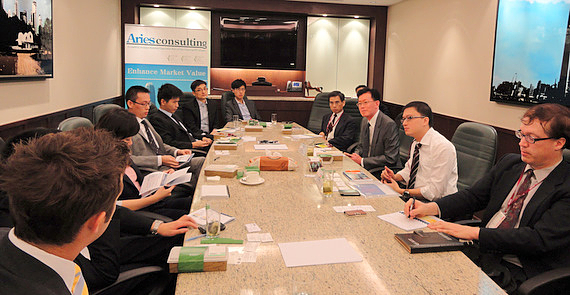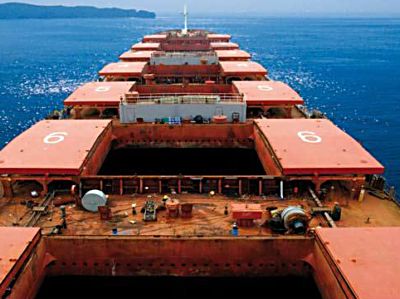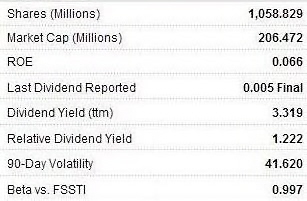
COURAGE MARINE Group Ltd (SGX: E91), which operates nine dry bulk carriers deployed around Asian ports, says its diverse fleet makes it flexible in responding to orders for commodities like coal, iron ore, sea sand, cement clinker and other items in high demand in the region.
Aries Consulting hosted an investor meeting on Thursday during which Courage Marine’s chairman said he was very bullish on the ability of China in particular to continue driving the market for bulk cargo.
“Catering to the needs of China’s incessant appetite for raw materials, our cargo mix in FY2009 included raw materials such as coal, bauxite, iron ore and sea sand,” Hsu Chih-Chien told the roomful of investors in Hong Kong.
And to help the Singapore-listed firm meet continued strong demand for bulk commodities fueling the still robust economies of the region, Courage Marine added a Capesize vessel to its fleet earlier this year for a second-hand purchase cost of around 10 mln usd.

But the company still expected to get even better deals for used vessels going forward because selling prices for finished ships were still too high.
“I still feel there is more room for downward adjustment in ship prices,” Mr. Hsu said.
He said many companies bought new ships in 2007 and 2008 at “spectacularly high prices.”
“But we only purchase second-hand vessels so even though prices for new ships are now around half of what they were just two years ago, we still feel they will go lower, and therefore second-hand prices will follow.”
The company's vessel mix was directly a response to the disparate requirements of a diverse product mix.
“Our Capesize vessel mainly transports coal, bauxite and iron ore while our four Panamax ships focus on thermal coal mainly for the energy needs of China. We feel there is huge potential for growth in the Chinese coal market,” he added.
Did Courage Marine expect to see pressure from alternative forms of energy cutting into China’s heavy reliance on coal?
“This country still relies on coal for the vast bulk of its energy needs. So if you want to know if I expect any slowdown in China’s coal demand, I would say – Not in my lifetime,” Mr. Hsu said.
The company’s fleet of nine vessels were purchased on the second-hand market, and include four Handysize vessels (total: 163,265 deadweight tons), four Panamax vessels (total: 267,375 dwt) and now, one Capesize dry bulk cargo ship (146,351 dwt).
This gives Courage Marine a grand total dwt of 576,991.
“Our diversified fleet provides flexibility to meet varied needs of our customers ranging from spot charter to long term COAs (Contract of Affreightment). The mix gives us much greater flexibility to respond to market conditions.
“Courage Marine’s diversified mix has enabled us to achieve stability as well as capitalize on growth and high margin opportunities over time,” Mr. Hsu said.
He also said that having three different classes of dry bulk cargo vessels in its fleet and a healthy revenue contribution from a variety of shipped commodities enabled the company to have excellent exposure to different non-correlated business cycles.

Courage Marine prefers to trade on the spot market because it provides better returns than contract shipments, he added.
Indeed, for FY2009 70% of revenue was derived from spot shipments versus 30% for COA.
Many investors at the luncheon were keen to know how the market perceived Courage Marine’s preference for second-hand vessels.
“I am often asked if our acquisition of used-only ships is economically feasible. Actually, we believe it is the best option for us and our shareholders and the proof is in the numbers. Not only do we enjoy considerable savings come fleet expansion time, but we also preserve our very healthy cash position as well.
“And most importantly, for the past ten years, our fleet utilization rate has averaged around 90%. This means average downtime is only around 10% of the time, a performance better than many of our listed rivals,” Mr. Hsu said.

Courage Marine posted strong second quarter results, with revenue in the April-June period rising 168.3% year-on-year to 16.3 mln usd and gross profit swinging to the black, coming in at 5.5 mln usd.
“We will use any market improvement as an opportunity to improve, renew and upgrade our fleet. We intend to continue to secure spot charter contracts as they typically offer premium rates, but we will also limit our potential exposure to short-term fluctuations in charter-hire/freight rates by allocating certain capacity to secure COAs.”
And how did Courage Marine plan to navigate the often stormy seas of vessel price fluctuations?
“We are always on the lookout for vessels offering good value at attractive prices to further reinforce the strength and efficiency of our fleet. Going forward, we will continue to be a company that is very active and flexible.
"To those who say our fleet is old, I reply that I have been in the shipping business myself for over 30 years,” Mr. Hsu said with a smile.
See also:
COURAGE MARINE: Picking Up Steam On Economic Rebound
COURAGE MARINE: Buying Old Ships, Working Them Efficiently





